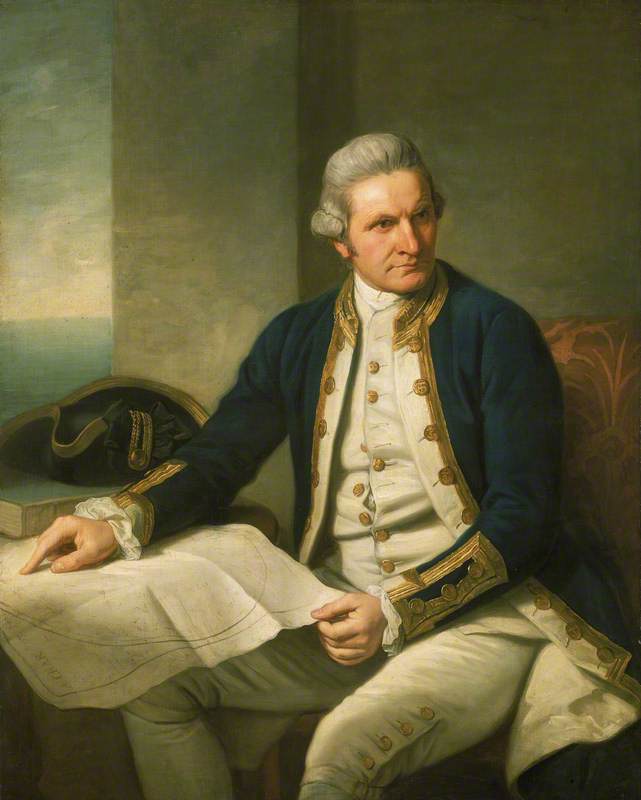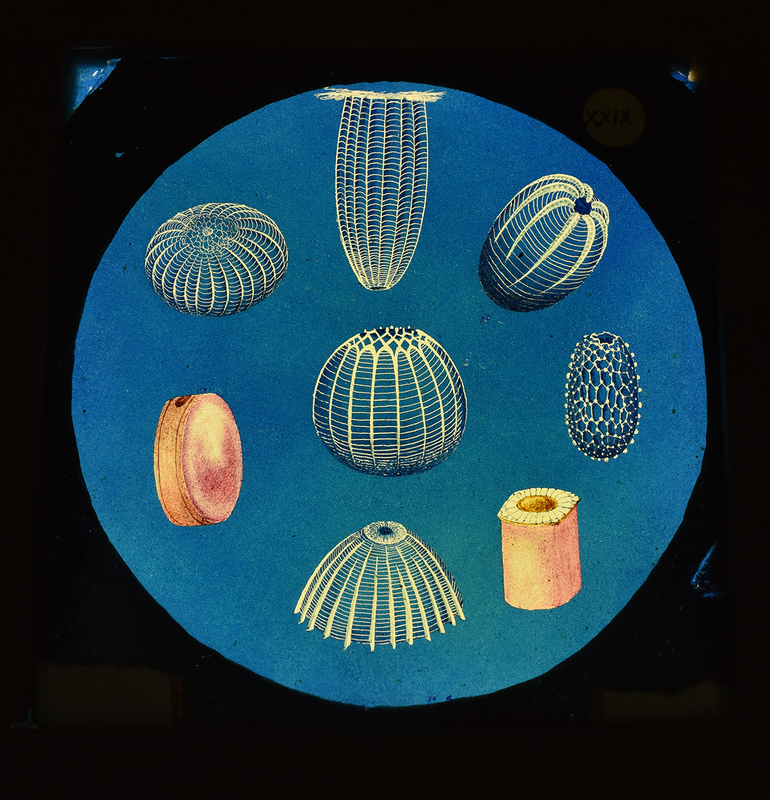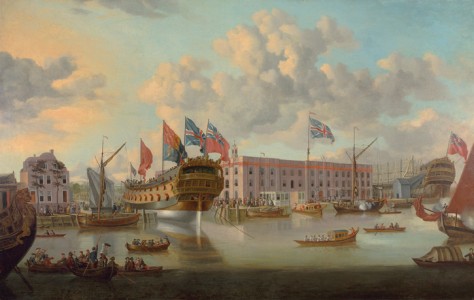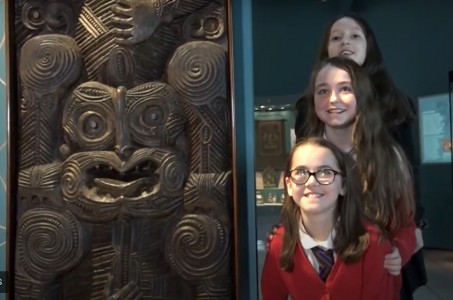Lieutenant, later Captain, James Cook defined an era of extraordinary maritime feats. Throughout his lifetime, he rendered the treacherous St Lawrence River navigable, charted the vast expanse of the Pacific, and advanced scientific understanding perhaps more than any other individual in his age. Yet his legacy is complex. To some, he is considered the founder of nations, while to others, he represents an overbearing and destructive imperial policy.
Captain James Cook (1728–1779)
1775–1776
Nathaniel Dance-Holland (1735–1811) 
In this painting, Cook is represented as a maritime master. Clothed in the uniform of a sea captain, he inspects a map of the Southern Ocean which he himself made. A book, perhaps his diary, lays on the table with a tricorn hat on top. Cook's diary is the key to our understanding of the emergence of the Pacific in European eyes in the eighteenth century.
Throughout his three circumnavigations, Cook advanced into regions previously untouched by European navigators. His famed first voyage, in HMS Endeavour, landed on a number of shorelines that shared the Pacific, such as the Society Islands, including Tahiti, the Austral Islands, New Zealand and eastern Australia. In each location existed a complex tribal structure that would forever be changed by European encounters.
A Māori bartering a crayfish with Joseph Banks
1769, image from 'Drawings illustrative of Captain Cook's First Voyage, 1768–1771', drawn by Tupaia (c.1725–1770), Polynesian navigator 
During the first voyage, the Tahitian navigator and arioi (religious figure), Tupaia, captured a simple scene: Joseph Banks bartering for a crayfish or koura with a Māori person from New Zealand. It is one of the earliest artworks by a Pacific Islander on paper. The civility between Europeans and Pacific Islanders would not last long.
In Cook's second voyage, he forayed into the deep south, coming close to Antarctica. The aim was to establish the potential existence of an undiscovered southern continent, terra australis incognita. He also visited the Friendly Islands, the New Hebrides, Tongatapu and elsewhere, noting the cultures and lifestyles of the people that lived there, making scientific observations, and taking specimens.
The Landing at Tanna (Tana), One of the New Hebrides
1775–1776
William Hodges (1744–1797) 
In this work by William Hodges, Cook is portrayed in a seemingly peaceful pose, while groups of islanders from what the Europeans called the New Hebrides observe with a mix of curiosity and consternation. Although the artist's aim was to profile new discoveries, an inherent racism is made clear: the Europeans hold centre stage and are presented as benevolent, with good intentions, while the island's long-time inhabitants are wrongly sidelined as uncivilised, primitive beings. Such representations of this kind of encounter are not uncommon.
Cook's last voyage attempted to locate the fabled Northwest Passage, as well as further chart the Pacific north-east, including modern-day western Canada and Alaska. On 14th February 1779, Cook was violently killed at Kealakekua Bay, Hawaii, following a series of quarrels.
The Death of Captain James Cook, 14 February 1779
c.1795
Johann Zoffany (1733–1810) 
Even in death, Cook dominates the painting: the Hawaiians are presented as scowling, vicious and bloodthirsty. It is a painting of an event that did much to negatively form early European perceptions of Pacific Islanders.
Cook's three voyages encountered newly 'discovered' lands: scientists and botanists recorded innumerable new species, eye-witnesses described contact with Pacific Islanders, and artists, such as Sydney Parkinson and Alexander Buchan, and John Weber, illuminated an area of the globe that had been largely unseen by the European public.
For the first time, the cultures and lifestyles of the Pacific were being introduced to European audiences in a detailed, colourful manner, which included depictions of a variety of subjects, such as illustrations of Māori Tā moko, or tattoos. Of course, such depictions were recorded to capture curiosities.
Sketch of a Māori man (after Sydney Parkinson)
1784, hand-coloured engraving by Thomas Chambers (1724–1789) 
Pacific landscapes that did not conform to European aesthetics received intense interest. Neoclassical perceptions of a unified landscape made way for a more scientific approach. Artists were forced to perceive landscapes dominated by exotic flora, fauna, atmospheric conditions and people.
A View of Matavai Bay in the Island of Otaheite, Tahiti
1776
William Hodges (1744–1797) 
However, the man charged with leading this expedition is the focus of intense historical debate. Cook's legacy is complex. On the one hand, he was a skilled surveyor, navigator, administrator and polymath, while on the other, he remains emblematic of the very worst aspects of imperialism – bloody violence, oppression, cultural theft, exploitation and invasion. Objects from across the Pacific continue to be displayed in European collections.
Admirers of Cook point to his astute navigational understanding, gained on the annual Whitby to London coal runs and the mapping of the St Lawrence River. He is also lauded for his teetotalism, abstinence from sexual relations in Tahiti, and dedicated work ethic. He is seen by many solely as a man of his age, formed by the attitudes and assumptions of the society in which he lived.
To Cook's critics, however, his legacy is dark, misguided and inexcusable. The first encounter between Cook and the Māori people was marked by bloodshed when a ceremonial display was misinterpreted as an attack. Likewise, the first encounter between Endeavour and the Dharawal people was marked by gunfire and hurling stones. Atrocities like these would be regularly repeated over the next 200 years.
The legacy of Cook as memorialised by statues, like this one in Whitby, misrepresents reality. Author and journalist Stan Grant noted that a statue in Sydney's Hyde Park recorded that Cook had 'discovered' Australia – an inaccuracy to which he drew attention, and suffered severe public backlash. Attempts to correct the historical record have deeply divided public opinion.
Glorification of Cook's achievements ignores the human consequences that befell Pacific Islanders and Indigenous Aboriginal Australians. The legacy of Cook's voyages persists to the present day, through systemic racism, misrepresentation and injustice. For too long, successive governments have either made assumptions over how to treat indigenous people, or kicked the can down the road.
Historians measure the impact of European contact by the gradual collapse of Pacific society between 1760 and 1820. Diseases were introduced, native environments were irreversibly altered by the introduction of foreign flora and fauna, trading systems were eroded as European goods were given greater value, and geopolitical relations between tribes changed as communication with European visitors became equated with military superiority.
Some artists have creatively interpreted Cook's legacy, including in this work by Keith Peacock, though it remains an uneasy task. Not only does the man represent the death-knell for many Pacific societies, but also the introduction of scientific and aesthetic structures and conceptions of world order that persist today.
Further reading
J. C. Beaglehole (ed.), The Journals of Captain James Cook On His Voyages of Discovery, Vol 1: The Voyage of the Endeavour, 1768–1771, Cambridge University Press, 1968
Frank McLynn, Captain Cook: Master of the Seas, Yale University Press, 2011
Peter Moore, Endeavour: The Ship and the Attitude that Changed the World, Chatto and Windus, 2018
Alan Moorehead, The Fatal Impact: An Account of The Invasion of the South Pacific, 1767–1840, Hamish Hamilton, 1966
Nicholas Thomas, The Voyages of Captain James Cook, Voyageur Press, 2003

































